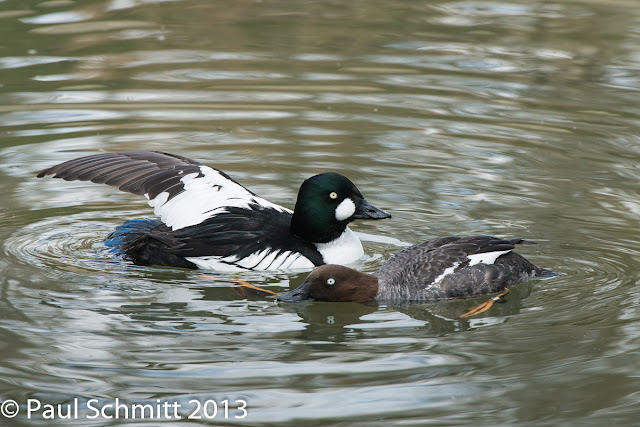Spring brings out all sorts of colorful and sometimes intricate displays, all controlled by each species' genes driving its host to perpetuate those genes. This is true for flora and fauna. For animals, the genes can drive the parent to pretty extreme behavior. So, I've recently come up with a few interesting displays in the bird world. Most were seen at a waterfowl park devoted to public education and breeding of rare wild waterfowl.
On a snowy March morning, this Hooded Merganser is displaying his hood to his mate.
Naturally, there are rival males that fly in to offer an alternative. Sometimes the competition is display, and in some species it can also be in vocalization. This guy was eager to display.
The male's display can take many forms. This Ruddy Duck, with his beautiful blue bill and rich red feathers puffs up his breast and bobs his head up and down to cause the water to bubble and shake. It is an amazing sight, comical to me but surely impressive to Ruddy Duck females.
Now, the competition among males is not always restricted to displays.and song. It can degrade into battle as these two Ruddy Ducks showed. The water flew for minutes as they fought.
It appeared (to me) that once a pair was bonded, the male-on-male fighting subsided. ( At times, the bonded female became aggressive to other ducks.) An intricate dance was sometimes shown as with this pair of Common Goldeneye Ducks. She was showing a submissive attitude with her body low in the water suggesting she was ready to accept the male. He was displaying his robust colors.
The male also displayed his strength with wild "dancing". Pretty impressive fellow, I'd say.
As the courtship continued, he came close and she eventually took a gentle hold on his wing by the white "bars". They spun around in a slow way, as he displayed his opposing wing. All very interesting. They mated under water as is probably common for diving ducks.
Naturally, all of this is a precursor to laying eggs and the female sitting on them for weeks before hatching the ducklings.
It seems that the larger birds have more ability to keep eggs warm in cold later winter. So, many are already hatching eggs as is the case for Bald Eagles, Great Horned Owls and some swans. These two (non-native) Black-necked Swans hatched the first of four eggs on March 30.
The male (cob) initially patrolled the island keeping the ducks at a distance, but soon he came in to examine the cygnet. Note one of the three remaining eggs is to right of the cygnet.








No comments:
Post a Comment